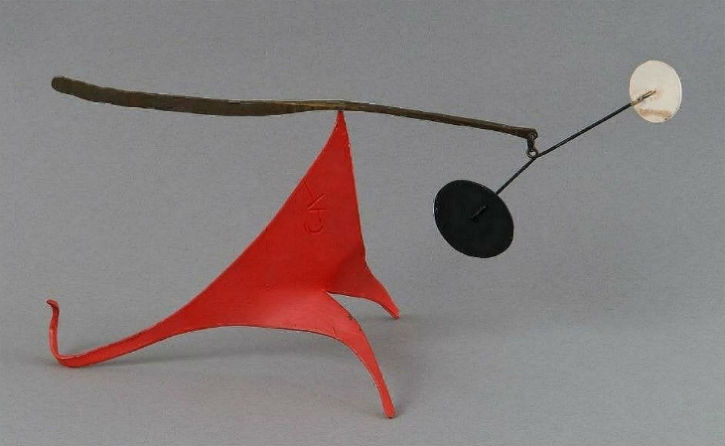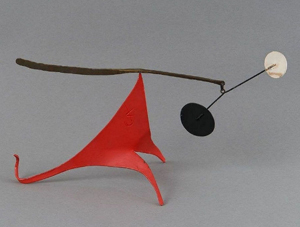
NEW YORK – Alexander Calder (American, 1898-1976), pioneer of kinetic art, began his career at age 11, by constructing a tiny dog and duck from trimmed, shaped make-do materials at hand. The duck, when tapped, rocks to and fro.
Though he earned an engineering degree at the Stevens Institute of Technology in Hoboken, New Jersey, Calder soon returned to his calling. After sketching scenes at the Ringling Bros. and Barnum & Bailey Circus in 1926, the artist, charmed by its kaleidoscopic colors, forms, movement and caprice, created a miniature circus of his own, Cirque Calder. By manipulating cunningly constructed make-do string, rubber, cork, cloth and wire animals and acrobats with cranks and pulleys, he produced entrancing, ever-changing, popular performances in New York and Paris. He also invented a new art form, by twisting and coaxing wire into three-dimensional sculptures, “drawing in space.”

Soon after, impressed by a display of colorful abstracts that artist Mondrian repeatedly repositioned in compositional experimentation, Calder created similar, carefully balanced, kinetic metal sculptures featuring curved and paddle-like motifs hanging together. His black, white and primary-colored “mobiles,” moving in space through light touch or slight air currents, created naturally shifting, freely moving interplays of forms and spatial relationships. Some produced sounds as well. These challenged the traditional belief that art is static.
From the 1930s, Calder also created whimsical, self-supporting “stabiles,” large and small. These simple, three-dimensional, contoured, structures, often unconventional combinations of wood, wire, paint, bone, metal rods and/or sheet metal, are designed to be seen from all angles. Like mobiles, their variable negative spaces – areas where objects aren’t – enhance their sculptural quality.

As Calder’s sculptures became increasingly abstract, his very collectible oil paintings balanced bright, pyramids, crescents, suns, moons, stars, amorphous figures, swirls and squiggles against exuberant blocks of pure color. Although these do not come to auction as frequently as his gouaches or lithographs, hammer prices are mostly between $400,000 and $1 million.
Through the last decades of his life, Calder expanded upon his earlier illustrative pieces, creating numerous prints in gouache, an opaque medium that allowed quicker construction than large scale, metal works. Though two-dimensional, their slender stripes, balloon-like discs, wildflowers, fantastic creatures and vegetable-mineral-like images pulse with life.

These joyous gouache drawings, explained Phillips, New York in 2017, “pull the viewer in with their luminous color palettes and palpable dynamism and immediacy. Covering the page with quick and assured brushstrokes, Calder transcribes his sculptural vocabulary onto paper – synthesizing the abstract geometric forms of his sculptures with representational, yet enigmatic and symbolic, motifs.” As his print production soared, scores of Calder lithographs, based on these paintings, reached the market. His earlier illustrations of poems, plays and short stories also became widely available.

Calder’s generally produced lithographs in limited editions. “Lower numbers in the editions,” explains Meredith Hilferty, director of the Fine Arts Department at Rago Arts and Auctions, “are not necessarily more expensive (on the secondary market) but prints from smaller editions can often realize higher prices. For example, a lithograph from an edition of 75 rather than 150 may command a higher price. Factors like image, size and condition also contribute to its desirability.” At auction, the majority of editioned works on paper (prints) are selling between $1,000 and $5,000 (hammer prices) each – provided they are signed and numbered.
In addition to toys, sculptures, paintings and prints, Calder designed theater sets, tapestries, bed headboards, rugs and jewelry. Rather than using traditional soldering techniques to create his brass, silver or gold pieces, he often linked their hammered components with handmade wire loops, rivets, fixings or findings. These items show tool marks.

Many of Calder’s stunning, sculptural silver earrings, cuff bracelets, pendant necklaces and rings are simply spirals or scrolls. Others, featuring incised Roman numerals or adorned with wood, ceramic, and glass bits and bobs, reflect the artist’s fascination with ancient cultures. His bold, bright necklaces – playful interplays of spirals, hearts, coils, waves and zigzags – also reflect Calder’s fanciful, childlike creativity.
Although Calder is long gone, his essence – his art – keeps moving.
# # #


